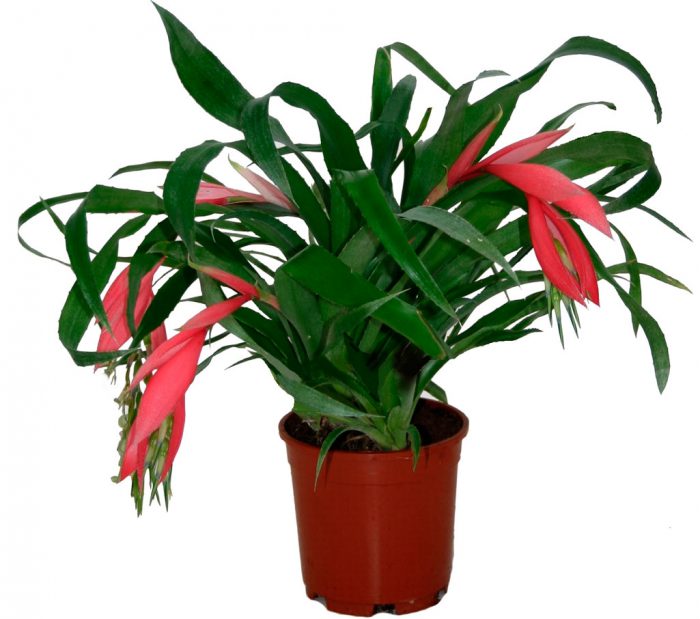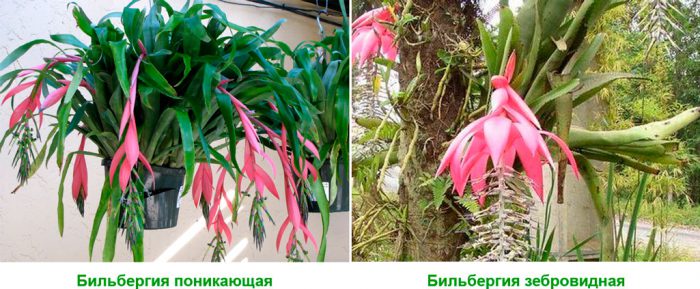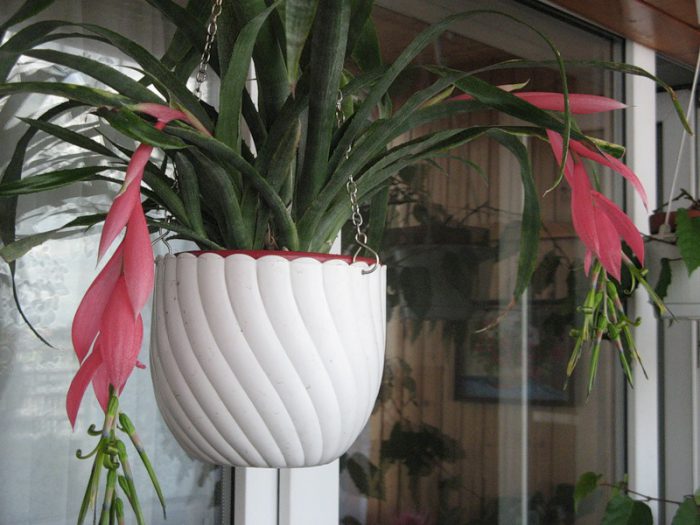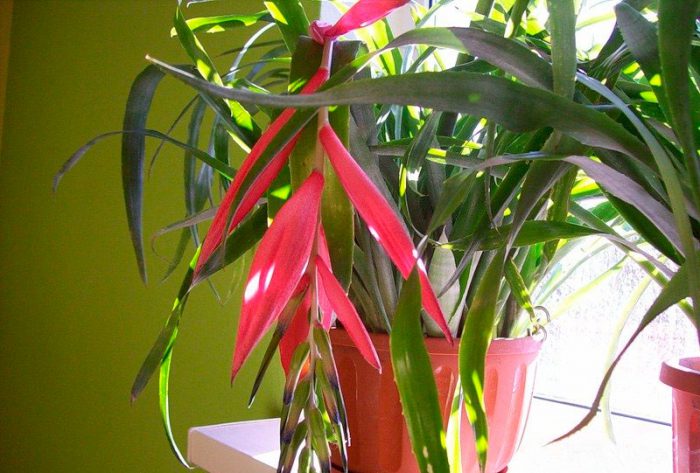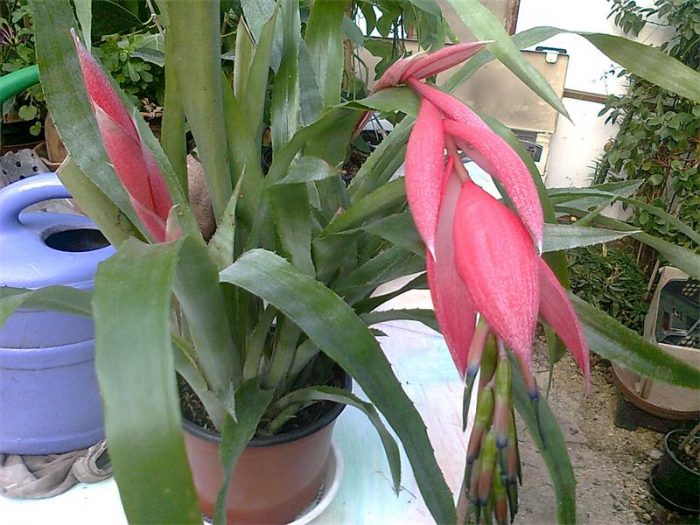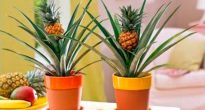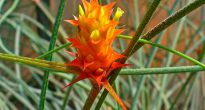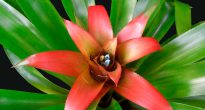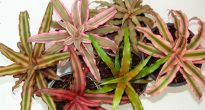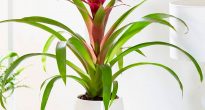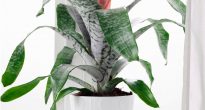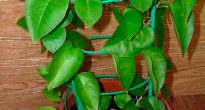Genus bilbergia directly related to the bromeliad family. It unites about 60 species of various epiphytic and terrestrial plants. This plant is native to the subtropical regions of South and Central America, where droughts are frequent, and temperatures can change dramatically during the day.
Due to prolonged droughts, this plant has formed a loose tubular leaf rosette, the purpose of which is to store and collect liquid. Linear, belt-like leaves are very hard and have small denticles or spines at the edges. There are species, on the surface of the foliage of which there is a waxy bloom of a gray color, which protects bilbergia from moisture evaporation.
This plant becomes most beautiful during flowering, which is observed twice a year, namely, in the spring and autumn. Flowers of various colors are attached to long peduncles growing directly from the center of the rosette of leaves. There are also large bracts of a rich color (often red or pink), they are collected in drooping inflorescences in the form of an ear.
The plant has new creeping lateral underground or aboveground shoots all the time, and at their ends, young leaf rosettes are formed. At the end of the flowering period, the mother's outlet dies off, and in the new season, already young plants begin to bloom. Gradually expanding, Bilbergia can form a very large colony, which will consist of many "offspring".
Indoor conditions are most often grown drooping bilbergia (Billbergia nutans), also referred to as "Queen's Tears". The plant reaches a height of 35–40 centimeters and has a green leaf rosette. The peduncle together with the inflorescence is 20-30 centimeters long, and it is painted pink. In half-open, light green flowers, the tips of the petals are painted in purple. The plant stands out with bright pink bracts.
And it is also very popular zebra bilbergia (Billbergia zebrina), which is also very popular with bromeliad growers. This is a fairly large plant. So, the leaves, which have a spectacular color, reach 80 centimeters in length. They are olive green and have wide, transverse, silvery stripes. It also has blue flowers and deep red bracts.
There are other species that grow indoors.
Content
Home care for bilbergia
Accommodation features
Bilbergia is grown. usually in flower pots placed on a windowsill. However, this is not the only way. So, they can be grown on the "bromelium tree", which is made from a large branching driftwood. To place a flower on a given tree, it must be freed from the pot, and soil must be removed from the roots. Then the root system must be completely wrapped with sphagnum moss, and then tied to the branches of the driftwood.
In the case when the size of the room is small, you can take a block from the bark of a tree and fix it on a shelf or wall.
The only difficulty of this placement method is maintaining the necessary sphagnum moisture.
Illumination
This plant is very fond of light, but at the same time it must be diffused. It should be shaded from the direct rays of the midday sun. It is recommended to place a window on the window sill located in the western or eastern part of the room. In the northern part of the room, bilbergia may lack light, resulting in a lack of flowering.
Temperature regime
It develops and grows well at moderate temperatures. So, during the growing season, it should be from 20 to 28 degrees. During the dormant period, the plant must be placed in a cool (15-18 degrees). A rest period is necessary for him, since thanks to the cool air, the development of flower buds is stimulated.
Bilbergia is not afraid of drafts and it can withstand temperatures down to 2-3 degrees (for a short time). However, it should be borne in mind that when a flower is kept at a temperature of 10-12 degrees, it usually gets sick.
How to water
In extreme heat, the plant should be watered regularly and abundantly. The soil should be constantly slightly moistened. But at the same time, make sure that no liquid stagnates in the soil. During the dormant period, watering is carried out after the topsoil has dried out.
In the spring-summer period, when watering, the liquid is poured directly into the leaf funnel, but if the room temperature is less than 20 degrees, then this water must be removed. In winter, leaf rosettes must be dry. And it is also forbidden to pour liquid into the funnel if the flowering period is over, as this can lead to rotting of the leaf outlet.
When placed on a "bromelium tree", watering is carried out after the sphagnum is completely dry. The plant must be removed, and the moss must be lowered for a third of an hour in a bowl of water. After waiting for the excess water to drain, the bilbergia must be returned to its place.
You need to water it with extremely soft and settled water for at least 1 day. You can also boil and cool the water before watering, or add citric or acetic acid to it.
Humidity
The plant needs high humidity (approximately 70-80 percent). In the spring and summer, as well as when the room temperature is too high, the flower must be systematically moistened. Also, to increase the humidity, you can pour expanded clay into the pan and pour in a little water (it is regularly poured).
During flowering, it is not recommended to spray the plant, but this is because moisture that gets on the petals can cause specks to appear on them.
Earth mix
Almost any soil is suitable for planting bilbergia, as long as it is water and air permeable, and also quite loose. So, ready-made soil mix can be purchased at the store. To create a suitable mixture with your own hands, you need to combine peat, leaf and humus soil, taken in equal proportions, and you also need to pour a little sand and chopped moss into it. Don't forget a good drainage layer.
This flower grows well in hydroponics.
Fertilizer
Top dressing is carried out during the growing season 2 times a month. For this, fertilizers are used for bromeliads.You can also take fertilizer for orchids or for flowering indoor plants (apply ½ part of the recommended dosage indicated on the pack).
It is necessary to feed with fertilizers containing not very large amounts of nitrogen, as this can cause the death of the flower.
How to transplant
The root system of Bilbergia is small and grows very slowly, in this regard, the transplant is carried out only when necessary (if the roots do not fit into the pot). An overgrown plant, as a rule, is separated during transplantation and planted in different pots.
The pot is chosen low and wide.
Reproduction methods
Bilbergia reproduces best and fastest in offspring, which are usually abundant on the mother plant. Flowering in young plants occurs after 2 or 3 years. Also, an adult plant can be divided. As a rule, a flower grown from a delenka blooms already next year.
The longest and most difficult is growing from seeds. So, you need to germinate seeds using a special technology, like growing seedlings.
Pests
Aphids can settle mealybug, scale insects or spider mites. The infected plant must be treated with a special insecticide (for example, actellic).
Possible difficulties
- The tips of the leaves begin to dry - there is no liquid in the funnel.
- The leaf rosette falls apart and becomes looser - lack of light.
- Light brown spots form on the leaves - due to direct sunlight.
- Leaf rosette of non-blooming bilbergia rots - the soil is waterlogged.

